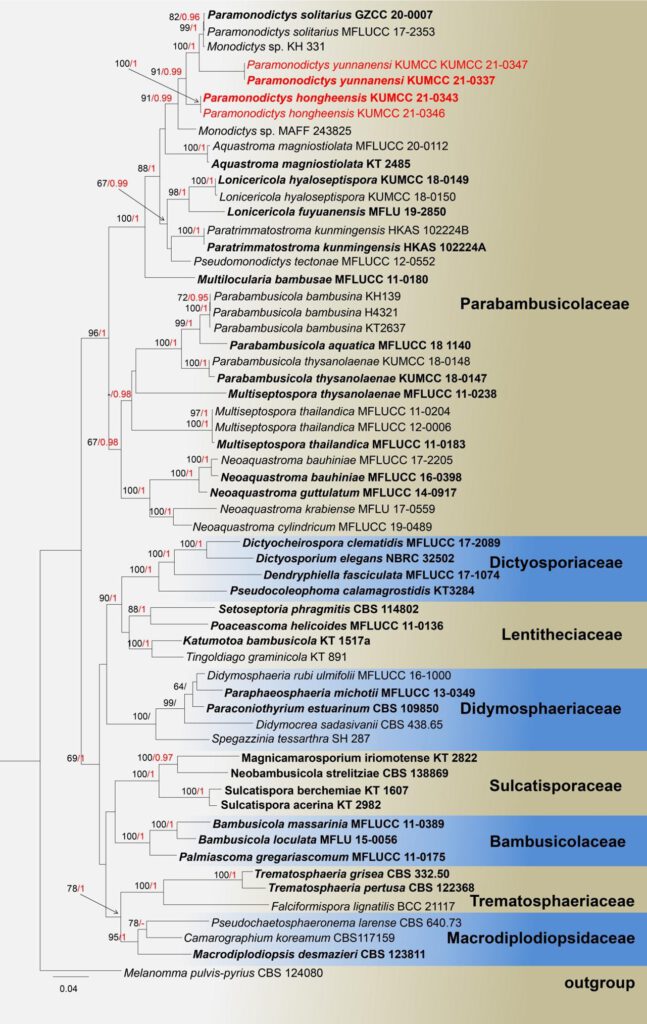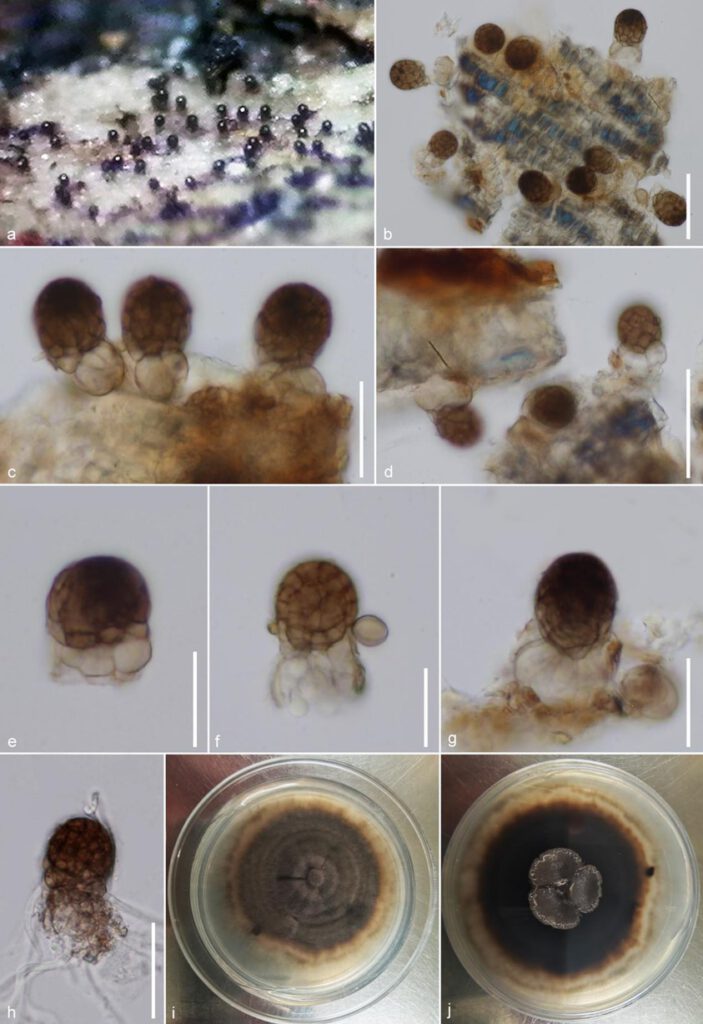Paramonodictys hongheensis E.F. Yang & S. Tibpromma, sp. nov.
MycoBank number: MB; Index Fungorum number: IF; Facesoffungi number: FoF 10592;
Saprobic on dead branch of Mangifera indica. Sexual morph: Undetermined. Asexual Morph: Hyphomycetous. Colonies on natural substrate scattered or gregarious, effuse, solitary to gegarious, subglobose to obovoid, visible brownish to dark brown spots scattered on the host surface, shinny, easily separating when disturbed. Conidiogenous cells 10–15 × 16–25 μm (x̅ = 12 × 20 μm, n = 20), monoblastic, subhyaline to brown, often subglobose to irregular, smooth or frequently appear vertical septa. Conidia 19–26 × 19–22 μm (x̅ = 23 × 21 μm, n = 30), subglobose to oval, muriform, thick-walled, multicellular with regular or more often irregular septation, apical part pigments dark brown, below part pale-brown to yellow-brown.
Culture characteristics: Conidia germinated within 18–20 hrs. on PDA. Colonies rapid-growing on PDA reaching about 15 mm diam., after 1 week at room temperature in natural light, above of colonies appear circular, umbonate, slightly radial striations, circinate, fluffy, entire edge, initially grayish to pale brown, finally exhibit dark brown when it mature after 1–2 month. reverse dark brown, reddish-brown near the margin, sunken at the centre, not pigment produced in PDA.
Material examined: CHINA, Yunnan Province, Honghe Menglong village on dead branch of Mangifera indica, (102 ° 50’ 11” E, 23° 41’ 01’’ N, 500.6 m), 24 July 2019, E.F. Yang, EFH005, Herb. KUN-HKAS 122190, culture holotype KUMCC 21-0343, culture ex-type KUMCC 21-0346.
Note: In our study, Paramonodictys hongheensis KUMCC 21-0343 has a high similarity with Mangifera melonopa PAN 32767 in morphology. Which introduced by Prasher IB & Verma RK (2016), conidia multicellular, muriform, subglobose to oval, pale-brown with below part, our isolation smaller than M. melonopa in conidia (19–26 × 19–22 μm vs. 26.45–46.13 × 19.53–27.8 µm), unlucky, we lack of genes for M. melonopa to compare with our isolation, and only two species Monodictys sp. MAFF 24385, and Monodictys sp. KH331 from available sequence data were complex and close to Paramonodicty branches with high sport value in ML and BI phylogenetic trees, and the trees’s shape highly similar with in (Dong et al. 2020, Hyde et al. 2020) we comparison of the 930 nucleotides across the tef1-a gene region, found a quite unmber of base pairs was different with Monodictys sp. KH331 and Paramonodictys solitarius (GZCC 20-0007, MFLUCC 17-2353). Therefore, based on conidial morphology comparison and phylogenetic trees, we proof Paramonodictys hongheensis KUMCC 21-0343 as new species was found in China on Mangifera indica is frist time.

Fig.X. Phylogram generated from Maximum Likelihood analysis based on a combined SSU, LSU, ITS, and tef1-a sequence datasets, 59 strains are included in the combined gene analyses 3540 total character including gaps (LSU:1-875 bp, SSU:880-1903 bp, tef1-a: 1908-2837 bp, ITS: 2842-3540 bp), Maximum likelihood bootstrap support values greater than 60% are shown in above branches, Tree topology of the ML analysis was similar to the BI. The matrix had distinct alignment patterns, with the final ML optimization likelihood value of -27170.920818 (ln). All free model parameters were estimated by RAxML model, with 1459 distinct alignment patterns and 21.90% of undetermined characters or gaps. Estimated base frequencies were as follows: A = 0.235389, C = 0.254603, G = 0.273057, T = 0.236951, with substitution rates AC = 1.064440, AG = 2.450499, AT = 1.326228, CG = 1.102216, CT = 5.326081, GT = 1.000000. The gamma distribution shape parameter alpha = 0.516907 and the Tree-Length = 3.201655. The final average standard deviation of split frequencies at the end of total MCMC generations calculated as 0.009940 in BI analysis. while Bayesian posterior probabilities greater than 0.95 are in bold. Tree topology of the ML analysis was similar to the BI. the type species bold and new isolates in red bold.

Fig. X. Paramonodictys hongheensis (KUN-HKAS 122190 holotype). a. Colonies on surface of bark; b–d. Colonies on host surface; e–g. Conidia with conidiogenous cells and conidiophore; h. Germinated conidium; i, j. Colony from above and below separately.—Scale bars: b, d = 50 μm; c, h = 30 μm; e–g = 20 μm.
